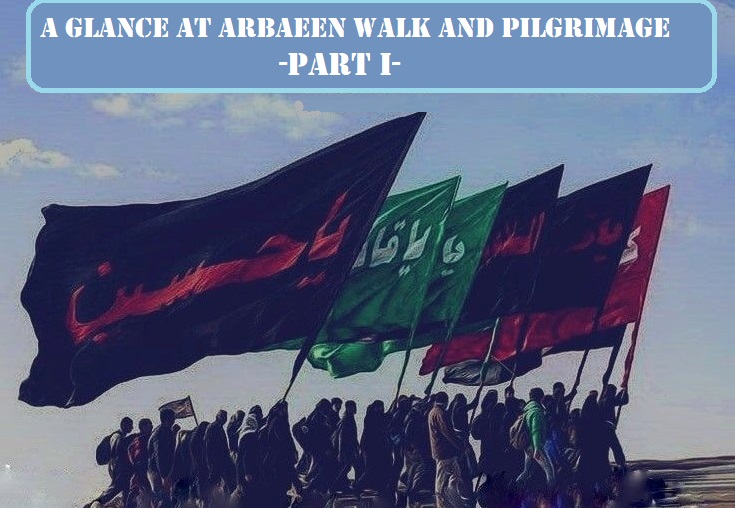This writing- addressing the eager Arba‘een pilgrims- while trying to inform pilgrims regarding the status and value of the Arba‘een Walk, also tries to acquaint them with their mission and that is to revere the name of the Hujjat (Chosen Proof ) of Allah, in addition tries to increase their ability to answer certain issues about Arba‘een.
According to an article by Ijtihadnet.com, Arba‘een is a manifestation of an astounding magnificence unto which, in recent years, has been added. It can uninhibitedly be said that many beautiful incidents, love and endearments, unheard and untold emotions have been intertwined together and created this marvelous event.
In regard to Arba‘een much has been said. From on-site observational descriptions, to stigmas and denunciations by some. From the numbers, to the narration of the culture of welcoming and accommodating pilgrims and guests going to the homes of poor Iraqis and a host sincerely giving all he has.
The Arba‘een convocation- due to the geographical extent that it covers, and due to its unique and wonderful happenings- is a great opportunity for recording events, writings and analyses. Analyzing pleasant occurrences and searching for their root causes can assist in their preservation and commemoration. This event cannot be overlooked inconsiderately; it must be told, heard, analyzed and conveyed to the next generations. God has not promised at all that He would easily preserve such glories without our endeavors and without any hardships.
From the Origination to the Consequences Throughout the Times
The founding of the Arba‘een Ziyāra hasbeen attributed to Jabir ibn Abdullah Ansari, who was of the Ashab of the Prophet (Peace Be Upon Him & His Progeny, PBUH & HP) and of companions of the Amir al-Mo’menin(PBUH). But in regard to the Arba‘een Walk, no precise report is at hand. Some of the elite, such as Sayyid Muhammad ‘Ali Qazi Tabatabayi in the book Research Regarding the First Arba‘een of Sayyid al-Shuhada (PBUH), have believed that the first Arba‘een Walks were at time of the Bani-Umayya and Bani-‘Abbas when the Shi’ah used to observe the Arba‘een Walk during the presence of the Imams (Peace Be Upon Them, PBUT).
But definitely the founder or better said the reviver of this great movement during Occultation was the late Shaikh Ansari; however, it did not last long or at least it was not deservedly restored.
That which we are witnessing today was started by the late Muhaddith Noori (1838- 1902 CE) and after him, with the Grace of Allah, still in this century this movement has almost uninterruptedly been persisting.
Jawad Shubbar- a contemporary Arab writer in the book Adab al-Taff aw Shu‘arā’ al-Husayn min al-Qarn al-Awwal al-Hijri hatta al-Qarn al-Rābi‘ ‘Ashar (a 10 volume collection about Imam Hussain (PBUH) poetry and poets throughout 14 centuries)- in a report from the Arba‘een convocation in Karbala, has compared the assembly in this observance with the assembly of Muslims in Mecca; he has mentioned the presence of mourning groups in the convocation reciting lamentations and elegies in Arabic, Turkish, Persian and Urdu. Adab al-Taff was published in 1968 CE and the author estimated that the number of mourners present in the Walk amounted to over one million. Actually the million presence in the Arba‘een Walk goes back to over half a century ago.
Of course, after the arrival of the first types of motor vehicles in the area the trips as old fashioned caravans were discontinued and travels were shaped in new styles. Then after a while- when Ayatullah Sayyid Mahmoud Hussaini Shahroudi (1883-1974 CE) was considered as one of the influential and significant spiritual teachers and experts of the Najaf Hawza- due to his requiring and insisting on going on foot to Karbala, again the issue of walking to Karbala as a holy trip became prevalent among Hawza students; meanwhile others with different nationalities such as some Iranians too occasionally accompanied them in the journey to the Atabat.
Indeed, with the coming to power of the Ba’ath Party in Iraq, pressure on the Shi’ah was, slowly but surely, going to increase. Since the Arba‘een Walk was one of the largest Shi’ah gatherings, this Walk was banned by the Ba’ath regime. The regime’s tough stance in forbidding the Arba‘een Walk and even the ziyāra of Imam Hussain (PBUH), temporarily obstructed this great movement for a few years.
Nevertheless in those very same years some of the locals, through palm forests and away from the main roads, used to, far from the eyes of regime guards, go on foot to Karbala. With the fall of the Ba’ath Party (2003) the Arba‘een Walk in Iraq was once again revived. Thenceforth every year, compare to the year before, more and more people have been participating in the Walk. At first, the Walk witnessed presence of 2 to 3 million pilgrims but in the following years, number of participating pilgrims in this Walk reached over ten million. With security established in Iraq and safety provided for most of the roads and with media coverage, the number of these pilgrims increased even more, so much so that according to Iraq’s Ministry of Construction and Housing the number of pilgrims has been reported 26 million in 2017.
According to on-site observations, a very significant point is that not only the Shi’ah but also some of the Sunni and even Christians and followers of other religions too, participate in this great event.

